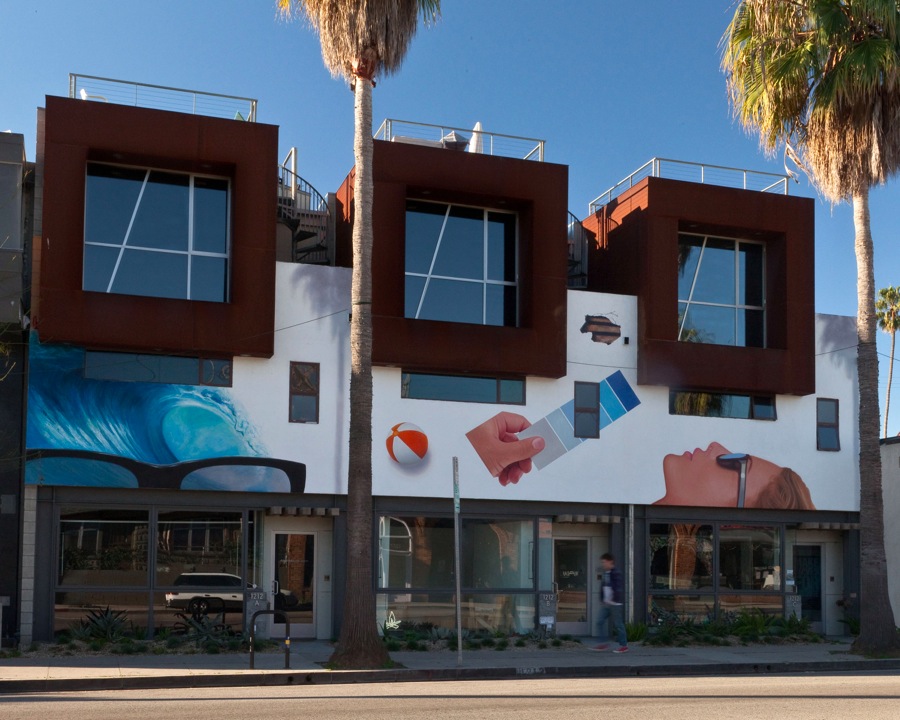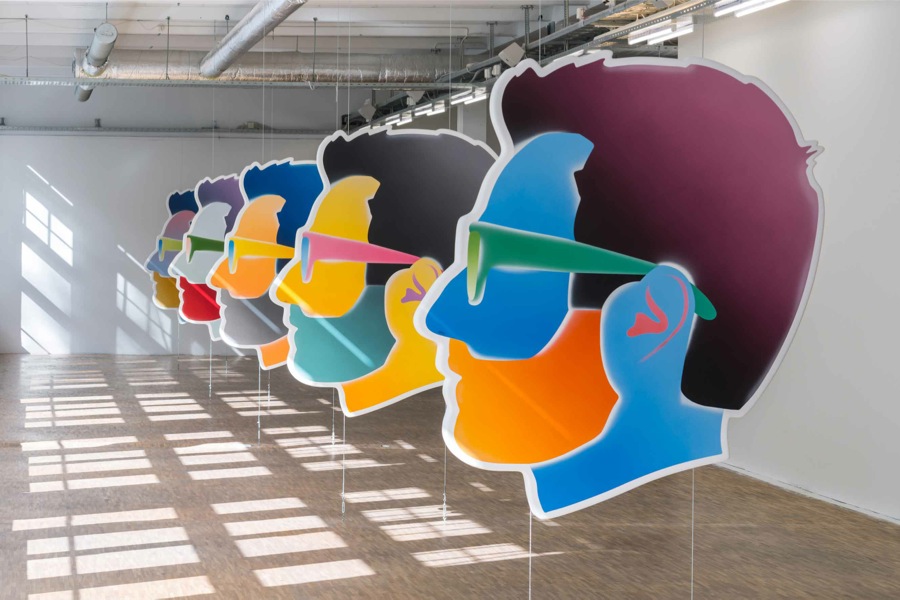|
Autor colaborador: Matteo Mottin |
 |
From January 16th Gagosian Gallery Rome hosts a two-person exhibition by Kathryn Andrews (Mobile, Alabama, 1972) and Alex Israel (Los Angeles, 1982). Both artists share a peculiar characteristic: they use temporality and contingency as new parameters for readymades, as a sort of renewal of Duchamp’s undermining of the status of authorship. Furthermore, they’re both based in Los Angeles and they’re interested in the culture of the local film and media industries. The multifaceted nature of Andrews’ work reflects her sensitivity to the decentralized urban sprawl of Los Angeles. Often she combines a meticulously fabricated “framing” element with a second notable object, the juxtaposition of which invites a multitude of implied narrative projections, while simultaneously de-stabilizing traditional assumptions about the formal hierarchies of sculptural pedestal, armature, and object.
 |
| Alex Israel, “Abbot Kinney Mural”. Foto: Michael Underwood |
 |
| Alex Israel, Museo Civico Diocesano di Santa Maria dei Servi, Città della Pieve. Foto: Ornella Tiberi |
Los Angeles is also a strong presence in Alex Israel’s work: from the set of vertical backdrop panels shaped like the windows and the doorways of the Spanish Revival homes of Hollywood’s Golden Age, painted with a thousand of overtones recalling the colors of LA Valley sunsets, “natural” environment for the rented movie props he exhibits as readymade sculptures, to “As it Lays”, his cult series of video-portraits of such notable locals as Rick Rubin, Marilyn Mason and Christina Ricci, just to name a few, to which he ask such harmless questions as “if you were to create the perfect salad, what would be the key ingredients?”.
The city is also an implicit presence in the name of his sunglasses’ brand, “Freeway Eyewear”.
Matteo Mottin in conversation with Alex Israel.
ATP: I know you’ve been to Cinecittà recently.
Alex Israel: I first went to Cinecittà last year in preparation for my first exhibition in Italy, which was in Umbria, in Città della Pieve, in a beautiful deconsecrated church with a Perugino Fresco, that is now a museum: Santa Maria dei Servi. I went to Cinecittà looking for props to rent, to use as sculptures for the exhibition as part of my ongoing sculptural project: Property. Employing cinema props as readymade sculptures is something that I’ve done in Los Angeles, New York, Berlin and Paris. When I returned to Cinecittà earlier this month, in anticipation of this exhibition at Gagosian Gallery in Rome, it felt like I was coming back to visit some old friends, the incredible props in the “Plastica” department at the studio. My selection process, choosing which props to use, is a lot like casting actors for a film. I walk the aisles at the prop houses, auditioning the objects for the role that they would have to perform in a show: the role of readymade sculpture. I look at the objects and I consider which ones have the most star quality. It’s really hard to explain what exactly I’m looking for–it’s an unmeasurable and ineffable quality–it’s something that you just feel. I spend a lot of time looking at things, taking pictures of the things that resonate for me, and then I begin making a selection. At this point it sort of becomes a “call back” situation, before the final selection is determined. Part of what inspires the selection is how the different objects relate to each other, and how I think they would work as a group or as an ensemble cast, working together in an exhibition. Because this is a two person show, of my own work and Kathryn Andrews’ work, there was definitely a consideration of how any objects that I might choose would relate to her works as well.
I believe that cinema props accrue a kind of magical property, or stardust, over time, through their experiences in film or on television. I feel this quality emanating very strongly from the objects that I’ve discovered here in Italy.
ATP: I read in an article about you that the subject of your research is the vacuity of celebrity culture, so I wanted to ask you…
A.I.: Sorry, that’s not correct. Not at all. I’ve never said that and I think it’s important to point that out here and now. I’m not interested in vacuity or emptiness. I think that celebrity culture is our culture, and I’m really interested in it and inspired by it. Some of my work engages celebrities. A lot of the celebrities I’m interested in are people that have made groundbreaking decisions that have paved the way for other people to follow in their footsteps. This is the fabric of our culture, and it’s neither empty nor vacuous.
A.I.: You invented a new way of intending readymades, giving new meaning to what they can be. How did you come to this? How did it start?
I was in art school and I was having an existential moment, not knowing what to make, or how to produce artwork. At the time I was genuinely convinced that I did not want to make art objects that could exist permanently as artworks and circulate in the art market system. On the other hand, I wanted to create art experiences that could be sculptural or physical for the viewer, much like the experiences of art objects I’ve had in the past–experiences that I’ve truly loved. I came to the conclusion that the best way for me to deal with this paradoxical interest, and to address the entertainment culture that is so interesting to me, and so much a part of life in Los Angeles, was to start thinking about renting cinema props. I started going to prop-houses. In LA we have so many of them and together, spread out across the landscape, the prop houses constitute a kind of library of objects. I just started going to them, taking pictures while learning, from experience, how certain things I’d come across might speak to me. At the same time, I was making sunglasses, and I was making videos for the internet. I insisted that my sunglasses were not precious, they were just a product that could exist in the world, and I knew that my video were also not precious, because they existed online and anyone could download them. I also knew that I didn’t want to alienate the possibility of participating in a dialogue that exists around the art gallery context. The idea of renting props, each able to perform the role of sculpture in a gallery, satisfied everything that I was looking to engage in my work at that time. Everytime I make new works in this way, I reconfirm my belief in the power, magnetism and magic of these inanimate cinematic objects.
ATP: So it kinda rises from an inner necessity.
A.I.: For as long as I can remember I’ve been making art. I studied art in college, and after college I worked in the art world. I experienced the art world from many different points of view: from working with artists, to working at art museums, to working with an auction house and two galleries. I saw the art market balloon into this incredibly powerful force, at times overpowering art itself. When I started graduate school in the fall of 2008, the subprime market crashed, and the art market changed along with it. I had collected a lot of experiences, and a lot of information during that time between college and graduate school, but I was still processing all of it. I didn’t know what to make of it and I guess that’s where the existential mindset came into play.
ATP: Sunglasses always remind me of “La Dolce Vita” and “8 1/2″. The way the characters wear sunglasses in Fellini movies is particular, almost ambiguous, as if they were children pretending to be grown ups, using them to shield their immaturity.
A.I.: Sunglasses are really interesting to me when I stop and think about them. I like how sometimes people wear them to hide, while other times people wear them to be noticed. They have this special quality that changes people: when people put them on, they instantly feel cooler. They’re kind of like a healthy version of smoking a cigarette. For those of us who live in Los Angeles, they are very simply a part of our everyday lives–you put on your underwear and you put on your sunglasses. So on the one hand they’re glamorous, and on the other hand they’re completely banal. I love these dualities, but I also Iove that at the root of it all, sunglasses frame and filter what we see, and they do it so effortlessly.
ATP: A last question: if you were to create the perfect salad, what would be the key ingredients?
A.I.: That’s a good question. Romaine, rucola, spinach, tomatoes, parmigiano cheese, chicken, green beans, corn, pecans, pomegranate seeds and light balsamic vinegar dressing. And avocado.
 |
Alex Israel Veduta dell’installazione di autoritratti del 2013 ad Isbrytaren, prodotta a Stoccolma da Carl Kostyal. Foto: Jean-Baptiste Beranger |
 |
| Alex Israel, “As It LAys” dalla mostra personale del 2013 presso Le Consortium a Digione. Foto: Zarko Vijatovic |
 |
Written by our friends at ATPdiary.com in colaboration with Matteo Mottin |


